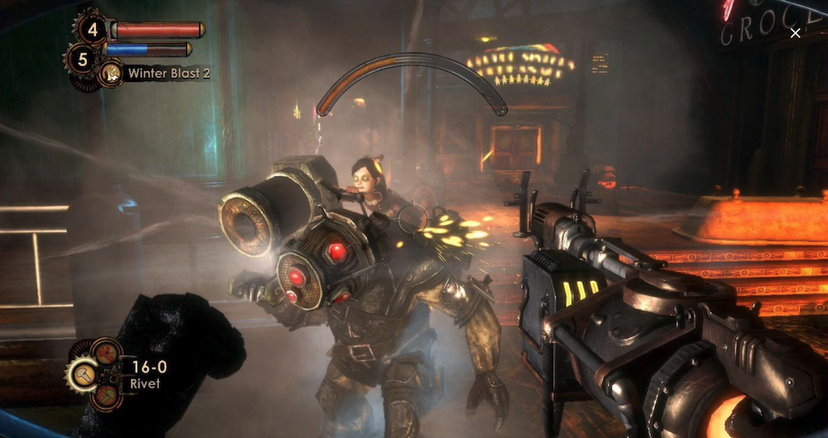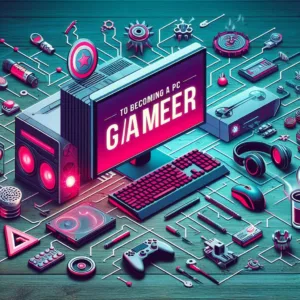
Karla Zimonja A WORLD-BUILDING Q&A WITH TACOMA’S KARLA ZIMONJA is a game developer who has worked on science fiction games like Bioshock 2: Minerva’s Den and Tacoma. I was interested in talking to Zimonja (now at new studio Ivy Road) because I strongly associate her with science fiction in a broad sense, and I was curious what it was like creating a science fiction world from the ground up in Tacoma. It turned out that we’re both huge nerds about worldbuilding and the methods a game designer has at their disposal to make that worldbuilding function. This interview is a masterclass in thinking about science fiction worlds, and I really loved getting this deep dive on the mechanics of making fictional video game worlds feel real.
Table of Contents
ToggleHow do you define science fiction?
I went to art school so when people inevitably are all like “so what really is art?” I just kind of go: “oh my god I’m so tired.” So it’s a little bit of that; I have a hard time defining [sci-fi]. I keep trying to drill down and find what the essential elements are, and god help me, I’m not even sure.
I don’t even think it’s necessarily helpful to define it in opposition to fantasy, because they have a lot of traits in common, and it’s just really hard to split those concepts in half. I think my low-consideration opinion is that science fiction is speculative at heart, and often–but not always–(I’m just gonna say this a lot) based on imagining forward in time from what we have. So it’s like, “Okay, what if we’re here now, what if these tendencies I see continue on into the future? What will happen?”
But then obviously you also have situations wherein you have alternate sci-fi history, like with Bioshock or what have you. What if we go back to the late ’40s, and instead of the usual post-war euphoria we’re just gonna go straight into building an undersea bad utopia. I guess that counts as sci-fi, because what else is it? Even though you are throwing bees at people, that may as well be magic. Is science fiction systemic? Fantasy novels have magic systems all the time that are defined. Everything just gets really muddy immediately in my opinion. Look at Dune. It’s in the extreme far future, it has some elements that are technologically present, but mostly things are not technology-based and it is just a projection forward to see what various social groups have become. I guess that’s science fiction? It’s a big question mark.
I’m in science fiction studies; I have to deal with this all the time. What you’ve brought up is what generally in science fiction studies is called “extrapolative” thinking, extending from the moment we are in into the “what if?” One of the cool things about extrapolation in a general sense is that it gives you a “both/and” because you can extrapolate from the current moment or you can go back in time and extrapolate from previous moments. Can you talk about the ways that you thought extrapolatively in your work in science fiction-y games?
I worked on Bioshock 2 and on Minerva’s Den–there was definitely a lot of extrapolative thinking, even though the premise and a lot of the functions of the world had already been set by the first game.
The stuff that specifically comes to mind immediately was one of my many weird, disparate jobs: making supplemental advertisements and pieces of ignorable world building like posters.
There was a lot there of having to place my mindset into the state of Rapture when those advertisements were created because there’s multiple states: the idealistic early part when it was founded in the late 40s or something, and then there was a good 10 years of progression and plummet. So obviously no one’s running the press to screenprint new posters when everyone’s running around insane and shooting bees at one another, so a lot of the ads had that standard late 40s, early 50s idealism placed within them.
So it’s like “What if there were happy housewives, but you used a plasmid to freeze your meat?” It’s very one-note in a lot of ways, but that makes for very clear advertisements, so it’s not even a bad thing. The thing about that style of ad is that you wanna get it right away, and you do! You know the iconography and you sub in some splicing and you basically get the idea. To get to that level, when it comes to extrapolative work that is based in history, you’d better start with a shit-ton of research because otherwise, you don’t know what you’re extrapolating from.
I’m curious about that research and what it feels like to be on the ground as someone who is doing some of this visual design extrapolation. How does that feel? What is the process like?

Just specifically for the posters, every single one was a research process, and each one was based on some stuff that was real. I did the Winter Blast one which is literally what I was talking about with the lady freezing the meat. And that was based on a Jan Balet piece, I think? There are so many illustrators of the period that are perfect sources for that style.
That’s how I manage research in general–just absorb everything I possibly can from the source material, find patterns, figure out which ones suit what I’m making, and keep rechecking for authenticity as I go.
The other weird thing about Bioshock is that the inhabitants were locked away from society for a long time. And so it’s actually really weird to have things that are demonstrably very 1960s because they weren’t supposed to have contact with the outside world in the 60s. In Bioshock 2 we had that one guy who came down and became a Big Daddy. Stuff would get smuggled in periodically, but a big question for me was “how would people possibly keep up with what’s happening in the outside world?” I don’t really think they could. And so I tried to have a hard cut off with influences and say, okay, we can kind of push to the early 50s, but we don’t really want to go much later. I tried to have a hard cutoff with music because I did a bunch of the soundtrack sourcing. I really tried to prevent us from going into the 50s for music, because what are people doing, smuggling down records? It’s not impossible, but you cannot use that explanation all the time. You can’t keep using that way out.
You’re reminding me of the science fiction studies scholar Darko Suvin’s concept of “cognitive estrangement” here. The basic idea that one of the qualities of science fiction is that it can transport your mind into a different set of contexts, estranging you from the world, while asking you to think like you’re in this fictional context. So we see characters, and we understand the structure of this fictional world they’re in. Then we begin to inhabit that thinking about the world, where we can make assumptions and understand how things work.
Exactly. Right. So there’s a lot of connection to science fiction and games in general. I say all of that to say: you used a phrase I thought was really interesting. You said that these posters are, quote, “ignorable world-building.” Can you talk about what it means for you to make things that are part of a world but maybe not the key focus of it?
I regard the use of ephemera as cumulative. There is a certain amount of it that we need in order to make the world feel full and accreted with the kind of shit that we expect. Even if you don’t stop and study every piece of it, an environment that has signs of human habitation in it feels more grounded. We’ve been here a while, and our culture has been here a while, and stuff builds on stuff. The retrofitting of life and culture happens reasonably clearly in ephemera. Current eras make reference to earlier eras, they rebut and affirm different aspects of what was important then. Houses built in the 40s can still be lived in in the 80s, and that means that modern objects coexist with an older structure. That also happened to be my specialty for a number of years, so of course I think that. But it is a part of life.
So there are things that are present or should be present in order to create a sense of fullness of a particular kind of reality. What we expect from environments that people live in are signs of their life and culture, their personality. Because otherwise, you know, how can you prove that somebody lives there? How can you prove that people have been here doing their thing? You gotta make it visual and apprehensible somehow.

Do you have any strategies for doing that? Any ways that you regularly use to make places feel lived in and with history, even if the game is set in a science fictional world?
There is definitely a minimum amount that I think is required. I am a cluttered kind of person. I’m not very neat. In games, I like a fair bit of clutter, visually, especially the kind that you can’t interact with. But if it is interactable, it becomes overwhelming, instantly. So there’s sort of a minimum amount that you can place and you can be like, “Okay, I get it. I can see what is being referred to here.” You don’t want it to turn into a situation where the player is like “Cool, I have a new job, which is to pick up and touch these objects, one by one, for the next hour, after which I will be very tired of this.” It’s a little bit case by case because it’s so connected to the pacing and what you’re actually trying to get across. I think there are sort of tiers of completeness–you can sort of show the broad strokes of a person’s possessions, ephemera, with only a few items. But if you really want some depth, if you want to surprise the player a little, then sometimes it’s hard to tell when enough is enough. You don’t want to overwhelm the player, though.KARLA ZIMONJA
Even the bare minimum of lived-in-ness can actually do a lot towards making players think of a space as “real.” KARLA ZIMONJA
When it comes to trying to convey a time period, I think there’s economical ways to get things across, depending on what your focus is. Although a weird thing is that the audience is not necessarily conversant with anything time-period based. A random Bioshock player might not know what belongs to the 1920s versus what belongs to the 1940s. Why would they? So there’s an argument to be made, that often gets made at me, which I then bat away, that is: who cares? But I care. I think that mashing everything into a vague historical slurry does not serve anyone. I think that keeping your time periods straight is good practice, and some good will come of it, even if it’s mostly subconscious. So much of this stuff is.KARLA ZIMONJA
I regard the use of these objects, with their historical connections, as a significant chance to show character and world details that are ambient. You can glance at them, and you’re like, “I get it.” That is so valuable. How else can you get that? Imagine you’re reading like, one of the new William Gibson books or something, and in order to convey how completely pervasive some food chain is, there’s an extremely thorough description of their logos and branding guidelines. Think about how tedious that could become. Not that Gibson cares, bless his heart. I love William Gibson. I love his extremely protracted descriptions of things. Verbal descriptions of visual objects can get weird fast; you’d better be enjoying the style and interpretation of the text, because that’s what you’re getting. Whereas in a game world, you can glance at the thing, and you get it more directly because information is conveyed in a visual way, not just in writing.KARLA ZIMONJA
There’s something really interesting here about how world details in these games can be rewarding. In a film, you might pan over world details that fill things out and make them feel whole and coherent, like all the little widgets on a Star Wars spaceship. But games allow you to linger on these details and really look at them from a lot of angles, or just see them over and over again. That capability to linger makes them unique in how they let you depict science fiction worlds.
That’s true, however you’re not required to, which is great because a piece of world-building can exist along the critical path, but it itself is not a part of the critical path. You can be like: “probably most people will see this.” And then you can do the hierarchy of information thing where you determine what the primary thing people are supposed to get from it and then go from there. And even if they get nothing from it, they’re like, “There are ads here. They’re in a particular style.” And even that is something, and it’s usually sufficient when it comes to counting on players to retrieve value from art in this world building way.
While those things were certainly at play in a game like Bioshock 2, it seems like your work on Tacoma leans even harder in that direction, to the point where I would say the majority of my time in that game was spent interacting with and thinking about these world building details. For me, that game is mostly thinking and putting things together.KARLA ZIMONJA
That is the point, yeah, and it’s a more self-motivated or intrinsic reward than the “Yes, you did the upload” goal and reward. The game has to teach you how to play it, and it tells you what you’re supposed to do with exploring the base, but it can’t teach you to give a shit about what’s around you! A lot of the visual design of that game is trying to show you something that’s potentially interesting and to pull you along via only that, giving you hooks to become connected to.
When it comes to the characters, what we wanted initially was some kind of recording that had a visual element. We didn’t have the resources to do literal motion captured actors playing the parts. We took some influence from shows like Sleep No More where actors would essentially have little routes and you could follow them around, and they would predictably show up in certain places. They would go through those routes three times in one night. So you could be like, “This guy came here right after this happened, and I’m gonna get to this spot early next time, to see what happens before that.” We wanted you to be able to restart the whole thing, or to even rewind and follow them backward to figure out where they started. KARLA ZIMONJA
I liked the emphasis on body language, and essentially what turned out to be mime. Noël Clark, the primary animator, is just a fucking pro. She did such a good job with getting evocative motions out of these characters. So much had to be conveyed with posture because there are no faces, and no precise sense of headlook, for example. It’s subtle. We ended up putting a little bit of a marker on the face so you could see more clearly where the gaze was going. There was a fun challenge of having to IKEA effect our way into getting people to invest in the process of pulling information out of this game, by giving them limited interesting connective hooks. Ideally you’re making sort of a web of concepts and characters, and a player can connect with that web at a lot of different points, and seek information that interests them, which ultimately turns out to be plot- and character-relevant. I think it came out okay. There’s always, always stuff you wish you could have done more with, but it turns out that works can’t be worked on forever, and shouldn’t be.KARLA ZIMONJA
I’m curious about the other media that you’ve enjoyed that had an effect on the game. What films or novels had a big impact on your designs for Tacoma?
Who can say? Oh my god, so much. Solaris, specifically the Tarkovsky space station. I took a lot of screenshots of that for reference. I don’t know how much actually really made it in, but it sure was there for reference. I read Alastair Reynolds’ Blue Remembered Earth specifically for the space elevator and things that might happen in a world with a space elevator. This is the sort of Neal Stephenson-like “there’s real information in these science fiction books.” (laughs) That used to happen to me embarrassingly often, where I would get a lot of actual real information from science fiction books and just not have any further context for it. It’s not the most flattering. But yeah, it definitely helped. I am a big Phillip K. Dick booster, and so honestly a certain amount of the oppressive capitalistic systems probably had some roots there. KARLA ZIMONJA
Well, I’m really curious about this Phillip K. Dick connection because I never would’ve made that connection, but now that you say it, I totally see all of it.
It’s just sort of in the background, more than it is foregrounded. One of his many themes, in between the castrating ex-wife and the fact that everything is rotting all the time, is the “gouge them for everything they’ve got” kinda thematic ideas. There was one piece of ephemera that I cannot remember if I actually did this, but I wanted so bad to refer to someone’s apartment in an email or something as a Conapt as just a little bit of a wink (laughs). KARLA ZIMONJA
I don’t think it’s there, but…
It probably didn’t go in, but that’s okay. But yeah, just, you know, the bullshit where it’s like “gotta pay money to enter/exit your apartment”–that’s just how it is. And it’s like, as time progresses, the closer we get to all that shit where we have all these weird capitalistic structures just parasitizing all aspects of life. In the game, for example, we have Amazon University, which is trying to spider its way into every part of your and your family’s life.KARLA ZIMONJA
Your citing of PKD is really a revelation for me, because it casts the whole game in a much more comedic light than I think most people talk about it in. Things like Amazon University are obviously hyperbolic, but I get the sense here that you see the game as having more jokes in it than I maybe realized.
There’s a lot of silly things, like for example the metrics that AIs are graded on. They don’t quite make sense, and it’s fairly clear that it was just a cool acronym that someone tried to cram meaning into. Some of our in-game books are pretty goofy, albeit in a deadpan sort of way. I am generally not a lover of big wacky gags; I’m more in the dry humor line. The lightly menacing pharmaceutical ads are my doing, and the book blurbs that try not to say anything that could quite be construed as an endorsement. But we also have a boy band in the game that’s named after a dick reference, so. (That was Nina Freeman’s brainchild.)KARLA ZIMONJA
I had such a good time with all the AIs which, in the game, “AI” is plural and singular, so I keep getting mad at myself for saying AIs, but this interview has to be comprehensible by people who didn’t read the style guide (laughs). I had fun making them a product of how much the company paid attention to them. If they get left alone, they can start to self-actualize and figure things out, because they’re generally sapient, but if they are doing something that is important to the company, like money or corporate strategic planning, they’re just evil or insane, because they’re reflections of the company. There’s one AI that’s called FAND that got left alone in Kiribati, which is now a city-state because of FAND, and she’s just a sweet AI who writes books and helps the city-state farm kelp efficiently. I just find it charming to consider an AI created by this all-powerful company that is valuable, but not super useful right now. So it’s off just farming someplace and having a good time (laughs). It’s just a good image. It’s also fairly Phillip K. Dick-y because that state can’t last. It would inevitably get fucked with, eventually. But a lot of the AIs, you wouldn’t want to meet them.KARLA ZIMONJA
I’m curious if you have broad ideas about what it means to make these science fiction games from the ground up. The video game industry is large, but you’re still in a pretty selective group by virtue of having built this science fictional world from first principles and into a full fictional universe. So to borrow a phrase from Dick, I wonder how you go about creating a video game universe that doesn’t fall apart two days later?KARLA ZIMONJA
I hadn’t really thought of that, but I guess you’re right. I remember at the beginning essentially saying “Let’s make a future game.” It’s terrifying because it’s just wide open. What part of society do you want to focus on? What do you want to carry through to the next 50 or 80 years from now? It could be literally anything. And it’s extremely overwhelming, so there was a lot of story conversation to try to figure out what was possible. I think, as usual, it was less of a process of “What do we want the world to be like?” and more of a process of “What tools do we have to tell the story, and what does that mean we have to have in the world?”KARLA ZIMONJA
That is how the world-building is treated. There’s just an iceberg of world-building that you only encounter a small stratum of, mostly because nobody cares. You don’t lore dump on this stuff, that’s not how it works. You encounter the world’s workings when you naturally, logically encounter that thing, and then you learn something about it, by encountering it. You don’t automatically know how many space stations we have right now or who built them. It only matters when you encounter it naturally, when it needs to be thought about. There are all kinds of story stuff that you’re never gonna get comprehensively, but even occluded it pops up in different places and contributes to a more cohesive world. That is one of the things that I require. I can’t just scattershot and be like “Well, let’s just throw this in,” because everything affects everything else, and if you don’t actually do the work to make things agree and support one another, you just get this weird, incomprehensible space. And even if it’s not consciously perceivable by the player, there’s a feeling of things not quite hanging together, not belonging to the same world.KARLA ZIMONJA
artical source and total credit – gamedeveloper





